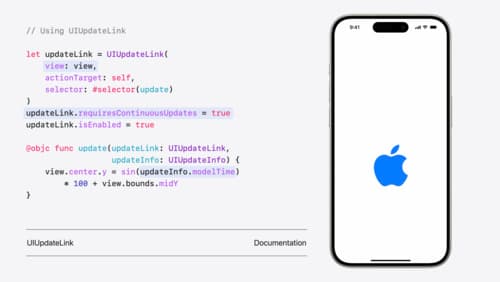What are the advantages of using cell configuration?
Asked on 2024-08-05
1 search
The advantages of using cell configuration, as discussed in the WWDC sessions, include:
-
Automatic Updates: When configurations are applied to a cell, they automatically update for the cell's configuration state. This means that properties will automatically match the style of the list, reducing the need for manual updates when the appearance changes. This is particularly useful in iOS 18, where the new list environment trait in the configuration state's trait collection ensures that configurations update their properties to match the list style.
-
Simplified Code: The use of cell constructors for content and background configurations simplifies the code. For example, the Files app uses the cell constructor for content configuration and the new list cell constructor for background configuration, which greatly simplifies the function that updates the appearance based on the
issidebarvariable. -
Consistency Across Platforms: Configurations are supported across all platforms, including iOS and macOS. This ensures a consistent experience and behavior of configurations across different devices.
-
Enhanced Customization: Configurations allow for enhanced customization options. For instance, in Quick Look, configurations enable users to switch between different colors or variants of a product within a single file, making it easier to explore different options without needing multiple files.
-
Synced Across Participants: In the context of FaceTime calls, configurations are synced between all participants, ensuring that everyone sees the same configuration, which is particularly useful for collaborative scenarios.
For more details on cell configurations, you can refer to the session What’s new in UIKit (09:49).
Relevant Sessions

Meet the next generation of CarPlay architecture
Dive into the architecture for the next generation of CarPlay. Learn how your vehicle system works with iPhone to create a single cohesive experience that showcases the best of your car and iPhone. Learn how UI is rendered and composited, and explore ways to configure and customize a special experience for each vehicle model. This session is intended for automakers and system developers interested in the next generation of CarPlay.

What’s new in UIKit
Explore everything new in UIKit, including tab and document launch experiences, transitions, and text and input changes. We’ll also discuss better-than-ever interoperability between UIKit and SwiftUI animations and gestures, as well as general improvements throughout UIKit.

What’s new in Quick Look for visionOS
Explore how Quick Look in visionOS can elevate file preview and editing experiences in your app. We’ll cover the integration of in-app and windowed Quick Look, as well as a brand-new API that customizes the windowed Quick Look experience in your app. We’ll also share the latest enhancements to viewing 3D models within Quick Look.
